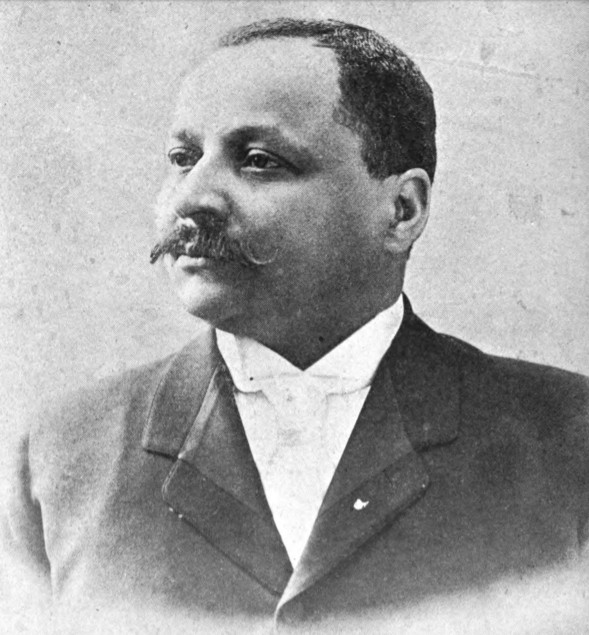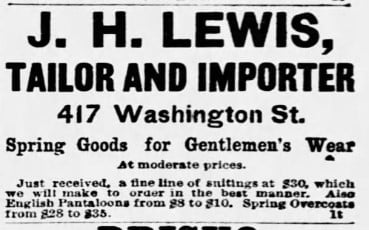
Dear Trinity Church and friends,
The more I learn about John Henry Lewis (1846-1918), the more of an enigma he becomes. He was one of the most successful merchant tailors of his time with stores located in downtown Boston and in Providence, RI. He was respected nationally by those in his trade and in the business world generally. He was socially and civically active. Though it does not appear he often took center stage to speak, he “spoke” powerfully with his wallet which was substantial. Like Booker T. Washington, he believed in investing in education. And like Booker T. Washington, he had come up from slavery. Unfortunately, unlike Washington, he did not write a memoir and tell the story of his life in his own words. So here are my few words …
John Henry Lewis would have been eighteen or nineteen years old at the end of the Civil War. He left the Enfield, North Carolina plantation where he had formerly been enslaved, and traveled north with a Union regiment that was returning home to Concord, NH. While in Concord, he apprenticed as a tailor. He eventually made his way to Boston to start his own business.
Well-made clothing was in great demand. Tailoring could be a very lucrative business. Handsome, articulate, and with an entrepreneurial spirit, Lewis excelled as a merchant, targeting his clientele expertly. With a starting capital of less than $100, he quickly grew his business, investing strategically in location (downtown Boston not far from Jordan Marsh) and in advertising to reach his primary audience, the wealthy Boston Brahmins and their children.

The size and placement of his ads are significant. He selected publications that attracted wealthy audiences like the Boston Globe. With ads in the back pages of theHarvard Lampoon, alongside those of Brooks Brothers, it becomes clear why some biographers state that his clients were sometime referred to as “the Harvard set.” His own son, his namesake, would one day attend Harvard after attending Phillips Academy in Andover, MA.
Of course, no matter how great the advertising, Lewis needed to back up his words with action. He needed to put the infrastructure into place and hire the right people to produce consistently great quality, stylish clothing. And he did. When asked many years later about his success, Lewis states, “If you produce what someone wants, he never questions who the maker is. He will buy. … you must have the ability to turn out good work.” He would become locally famous for promoting a new menswear style: bell-bottom trousers.
By the late 1890s, Lewis was reportedly the second largest merchant tailor in Massachusetts and fourth largest in the U.S. He paid $10,000 a year in rent and employed more than 50 men and women, both black and white. His business earned an estimated $150,000 to $175,000 per year. As a self-made man of means, he invested in property in Boston and in southern states, including purchasing the plantation where he had been enslaved. Horse racing was especially popular in the late 19th/early 20th centuries. Lewis maintained a stable of the finest racehorses.
On September 27, 1877, thirty-year old Lewis married twenty-year old Harriet Smith Peake. She was the only child of Mary Smith Peake, a free woman of color who was famed for teaching the first freedmen (the formerly enslaved also referred to at the time as “contraband,”) beneath a tree in Hampton, Virginia. The tree still standing today and known as Emancipation Oak.
By 1880, Lewis and Harriet had two children, John Henry Lewis Jr. and Mary Peake Lewis. The Lewis family were prominent among Boston’s black elite composed of successful businessmen and women, doctors, lawyers, and musicians. Not all of them were equally wealthy, but they had in common a certain class. Social historian Willard B. Gatewood refers to Harriet as dominating the fashionable “South End set.” The equally fashionable “West End set” was led by the wife of T. A. Ridley, Lewis’s chief competitor. Cultured, politically, and socially active, they lived lives in parallel with their white, wealthy counterparts. They would vacation in the same exclusive areas like Martha’s Vineyard and Newport. They attended the same opera houses, playhouses, and even the same churches … and sometimes at the same time. Segregation in Boston was not as prevalent as it would later become. The Lewises attended Trinity Church with fellow black Bostonians Josephine St. Pierre Ruffin, Lyde Benjamin, and Samuel Courtney among others.
As reported in an 1894 edition of The Woman’s Era, a publication founded for women of color by Josephine St. Pierre Ruffin and her daughter Florida Ruffin Ridley: “At the last confirmation at Trinity Church a new and beautiful feature introduced was the giving of flowers with the confirmation certificate to each candidate. The beautiful font was filled with long-stemmed Catherine Mermet roses which, after the services were over [Rector] Dr. Donald distributed to each of his new members. Mrs. J. H. Lewis, her young daughter, Mary, and her sister, Miss Melvin were members of the large class confirmed.”
In 1900, Booker T. Washington chose Boston to launch the National Negro Business League. Lewis was one of the invited speakers. He had been a proponent for such a gathering of successful black business leaders since the early 1890s. His remarks were brief but inspiring concluding with:
“I have found in my own experience of thirty years in business that success and its conditions lie all around us, regardless of race or color. I believe that it is possible any man with the proper stuff in him to make a success in business, wherever he may be. … Mr. Washington, in his great speech at the Atlanta Exposition, said to the Negro” “Cast down your buckets where you are.” To the young man who would succeed in business I commend the advice with all my heart. The material universe lies all about you. Get hold of this earth and make it your own. Make for yourselves a place in the business of the community in which you live, a part of its life and development, and gradually every barrier will be burned away. You will solve the problem for self, for race and country. Then will dawn the better, brighter and happier day for race and country.”
In 1902 Harriet suddenly died. Her passing was noted in a North Carolina newspaper, The Roanoke News. “She lived to see her husband a prominent merchant of Boston, not only a substantial property owner of that city, but the owner also of the plantation upon which he was born and the founder of a school upon that plantation. In the death of his wife he has the sympathy of the white people of this community. The funeral services were conducted by the assistant rector of Trinity Church, at one time under the rectorship of the late lamented Bishop Phillips Brooks.”
The Boston Globe reported, “The funeral of Mrs. Harriet Peake Lewis, wife of J. H. Lewis, a well-known local tailor, was held at her home on Columbus Ave today at noon. There was gathered there a large number of near friends and relatives. The burial service of the Episcopal church was read by Rev. Edward Borncamp, assistant rector of Trinity Church. … The pallbearers were Dr. Samuel N. Courtney, Ulysses Ridley, Joseph Lee and William Comer. The internment is at Mt. Auburn.”
Lewis eventually remarried to prominent Philadelphia educator Dora Cole. Along with great opportunities, the early 20th century brought economic challenges for Lewis. People were increasingly able to shop for quality clothing items in department stores versus needing custom tailored goods. Over time Lewis’s health declined. He and his wife would take occasional restorative respites to their North Carolina home.
Once he effectively retired, he turned over the running of the company to his son, John. It appears John may not have been successful at weathering the challenges of the tailoring trade in a changing world. The company closed and its remaining merchandise and stock sold in 1916.
After a storied career and legacy of leadership in the black community, John H. Lewis died in the winter of 1918. He is buried in a family plot at Mount Auburn Cemetery in Cambridge, MA.
Until next month,
Cynthia
Sources and Further Reading
- Cromwell, Adelaide M.The Other Brahmins: Boston’s Black Upperclass 1750 to 1950.
- Gatewood, Willard B. Aristocrats of Color: Boston’s Black Elite, 1880 to 1920.
- Hayden, Robert C. African-Americans in Boston: More Than 350 Years.
- Hewitt, John H. “A Black New York Newspaperman’s Impressions of Boston, 1883.” The Massachusetts Review, vol. 32, no. 3, 1991, pp. 445–63. JSTOR, http://www.jstor.org/stable/25090281.
- Miller, Melvin B. Boston’s Banner Years: 1965-2015: A Saga of Black Success.
- Richings, G. F. Evidence of Progress Among Colored People (1902).
- Hampton University and Emancipation Oak
- Mary S. Peake, The Colored Teacher at Fortress Monroe.
- The Woman’s Era, produced 1894-1897, by Josephine St. Pierre Ruffin and her daughter Florida Ridley

